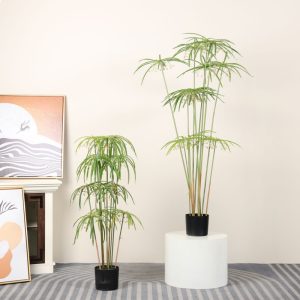Artificial plants are used across hotels, shopping centers, exhibition halls and commercial venues because they are durable and low-maintenance. When they reach end-of-life, procurement managers and facilities teams must decide how to dispose of them responsibly. This guide offers clear, practical steps — recycling, reuse, donation, procurement changes, and documentation — specifically for B2B buyers who need compliance and measurable sustainability outcomes.

Why proper disposal matters
Most artificial plants combine plastics (PE, PVC, polyester) with metal frames and sometimes coatings or foams. These mixed materials are not biodegradable and can place long-term strain on landfills and waste systems. Beyond environmental impacts, poor waste handling can cause reputational harm, regulatory fines, and higher lifecycle costs. A planned disposal strategy reduces waste, manages compliance risk, and can even lower total cost of ownership over time.
Quick 6-step disposal workflow
- Audit & inventory: Record quantities, photos, and the supplier’s Bill of Materials (BOM). Attach a short tag (e.g., AP-2025-001) to large items for tracking.
- Assess reusability: Flag items suitable for reuse or donation. Capture condition photos.
- Segregate by material: Separate metal frames, plastics, textiles and foam. Clearly label bins for staff and logistics teams.
- Select certified vendors: Contract recyclers or waste handlers who accept the required material streams or offer take-back programs. Request references and handling certificates.
- Document and audit: Use transfer manifests and recycling certificates. Store digital copies for ESG reporting and audits.
- Close the loop: Return recyclable materials into supply chains or negotiate recycled-content credits with suppliers.
Recycling — what to expect
- Metals: Readily recyclable through standard scrap channels once disassembled.
- Plastics: PE and mono-polyolefins are often recyclable locally. PVC and mixed blends are harder and may require specialist processors.
- Textiles/foam: Some polyester textiles can be recycled by textile processors; PU foams often need specialist handling.
Tip: Prefer products designed for disassembly. Avoid sealed or glued assemblies that block recycling.
Upcycling, donation and asset reuse
- Maintain an internal event asset pool for reuse of panels and trees.
- Partner with local theatre groups, community centres or event decorators for donations. Get donation receipts for documentation.
- Repurpose parts for seasonal displays or training props.
Procurement clauses & supplier questions
Ask suppliers for: BOM, recyclability statements, recycled content %, and take-back options.
Sample clause:
Supplier must provide a Bill of Materials, end-of-life instructions, and an optional take-back program. Returned items accepted under the take-back program will be credited against future purchases at a pre-agreed rate. The supplier shall assist in providing recycling certificates upon request.
Compliance, certificates and documentation
Retain inventory lists, signed manifests, photos and recycler certificates for each disposal. These support audits and ESG disclosures.












